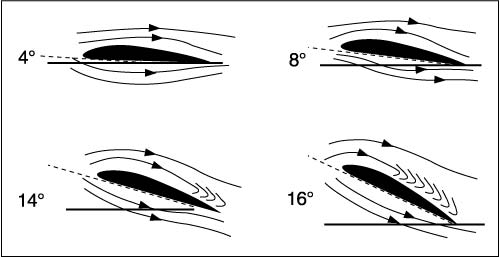As the angle of attack is increased (to increase lift), air will no longer flow smoothly over the upper wing surface but instead will become turbulent or “burble” near the trailing edge. A further increase in the angle of attack will cause the turbulent area to expand forward. At an angle of attack of approximately 18° to 20° (for most wings), turbulence over the upper wing surface decreases lift so drastically that flight can not be sustained and the wing stalls. See the figure below.

The angle at which a stall occurs is called the critical angle of attack. An airplane can stall at any airspeed or any attitude, but will always stall at the same critical angle of attack. The indicated airspeed at which a given airplane will stall in a particular configuration, however, will remain the same regardless of altitude. Because air density decreases with an increase in altitude, the airplane has to be flown faster at higher altitudes to cause the same pressure difference between pitot impact pressure and static pressure.
An aircraft will spin only after it has stalled, and will continue to spin as long as the outside wing continues to provide more lift than the inside wing and the aircraft remains stalled.
Here are some sample private pilot knowledge test questions. You can find answers with explanations below, no scrolling down and cheating!
1. The angle of attack at which an airfoil stalls will
A—change with an increase in gross weight.
B—increase if the CG is moved forward.
C—remain the same regardless of gross weight.
2. During an approach to a stall, an increased load factor will cause the airplane to
A—stall at a higher airspeed.
B—have a tendency to spin.
C—be more difficult to control.
3. During a spin to the left, which wing(s) is/are stalled?
A—Neither wing is stalled.
B—Both wings are stalled.
C—Only the left wing is stalled.
4. As altitude increases, the indicated airspeed at which a given airplane stalls in a particular configuration will
A—decrease as the true airspeed increases.
B—remain the same regardless of altitude.
C—decrease as the true airspeed decreases.
ANSWERS AND EXPLANATIONS
1. The angle of attack at which an airfoil stalls will remain the same regardless of gross weight.
When the angle of attack is increased to between 18° and 20° (critical angle of attack) on most airfoils, the airstream can no longer follow the upper curvature of the wing because of the excessive change in direction. The airplane will stall if the critical angle of attack is exceeded. The indicated airspeed at which stall occurs will be determined by weight and load factor, but the stall angle of attack is the same.
Answer (A) is incorrect because an airfoil will always stall at the same angle of attack, regardless of the CG position or gross weight. Answer (B) is incorrect because an airfoil will always stall at the same angle of attack, regardless of the CG position or gross weight.
2. During an approach to a stall, an increased load factor will cause the airplane to stall at a higher airspeed.
Stall speed increases in proportion to the square root of the load factor. Thus, with a load factor of 4, an aircraft will stall at a speed which is double the normal stall speed.
Answer (B) is incorrect because an airplane’s tendency to spin does not relate to an increase in load factors. Answer (C) is incorrect because an airplane’s stability determines its controllability.
3. During a spin to the left, which wing(s) is/are stalled? Both wings are stalled.
One wing is less stalled than the other, but both wings are stalled in a spin.
Answer (B) is incorrect because both wings must be stalled through the spin. Answer (C) is incorrect because both wings are stalled; but the right wing is less fully stalled than the left.
4. As altitude increases, the indicated airspeed at which a given airplane stalls in a particular configuration will remain the same regardless of altitude.
An increase in altitude has no effect on the indicated airspeed at which an airplane stalls at altitudes normally used by general aviation aircraft. This means that the same indicated airspeed should be maintained during the landing approach regardless of the elevation or the density altitude at the airport of landing.
Answer (A) is incorrect because true airspeed does not decrease with increased altitude, and indicated airspeed at which an airplane stalls does not change. Answer (B) is incorrect because the indicated airspeed of the stall does not decrease with increased altitude.




